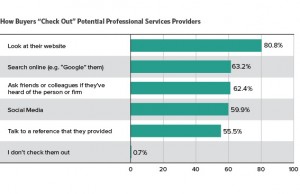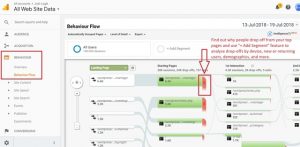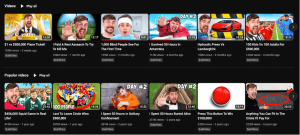Contributor Ben Jacobson taps 10 software gurus to reveal how SaaS marketers can bake marketing right into their products.
 Software as a service, or SaaS, has been experiencing quite a boom over the past few years, and it doesn’t appear to be slowing down anytime soon. Statista reports that from 2010 to 2016, the industry grew from $10.7 billion in annual revenues to a cool $32.8 billion.
Software as a service, or SaaS, has been experiencing quite a boom over the past few years, and it doesn’t appear to be slowing down anytime soon. Statista reports that from 2010 to 2016, the industry grew from $10.7 billion in annual revenues to a cool $32.8 billion.
The opportunities are huge for SaaS marketers — particularly those who are already in the market and poised to continue growing rapidly. On the other hand, the more SaaS products hit the market, the harder it becomes to continuously draw the kind of buzz you need to drive sustained growth.
That’s why SaaS often has growth mechanisms baked into the product experience itself. Customer acquisition for SaaS companies becomes much easier if the product can bring in new users and more dollars on its own.
Regardless of where you stand on the growth hacking debate (meaningless buzz term or a revolutionary discipline?), many of the biggest SaaS success stories we’ve seen in recent years are closely tied to the growth hacks that helped them build momentum.
Typically, there’s a product feature that brilliantly drives growth, or there’s a feature that’s so on-point with the needs of target users that buzz becomes inevitable.
Consider the classic example of Dropbox’s incentivized referrals, built into the app’s onboarding experience. Whenever a user signed up, they were given the opportunity to earn more free storage space for getting their friends to use it, too. Because referred users also benefited from the exchange, the product quickly took on a life of its own, cementing this feature’s place in the pantheon of brand advocacy marketing.
Or look at how Square’s visionaries knew that mobile point-of-sale systems equipped with card readers were destined to be in high demand. Before Square entered the market, many small business owners couldn’t accept credit card payments because they couldn’t afford the necessary merchant registration fees and requirements. As consumers shifted away from cash in favor of plastic, micropreneurialism was on the rise, and the rest is history.
The good news for product and marketing pros is that SaaS development pretty much always goes hand-in-hand with agile methodology. Rapid iterations make for constant opportunities, as there’s always an upcoming dev cycle to aim for with a new feature that can change the game.
So how can SaaS makers and marketers bake growth into a product’s features? Let’s see what the experts have to say.
Neil Patel, founder at Crazy Egg and NeilPatel.com

The best way to identify the features that’ll help drive growth is to compile loads of data and feedback. By combining qualitative and quantitative data, you can truly understand what your users want, which is what they will eventually find most useful. And that’s how features drive SaaS growth — by delighting users, so they feel good about spreading the good word among their peers.
The more agile you can be with these processes, with quick cycles of gathering requests, measuring various aspects of app use and building out the things that are most in demand, the faster your growth will be.
Pekka Koskinen, founder and CEO at Leadfeeder

The best way to understand what kind of features to develop in your SaaS product is to use the product yourself and talk with other users. From other users, you can get lots of great incremental improvement ideas, but typically they cannot think of features that will get your product to the next level. This is why it’s important for you to use the tool in your own business, to validate that the product really solves what it’s supposed to.
If you cannot use the tool in your own business, try to work as closely as possible with some key customers where you can test your ideas. After implementing the product features, make sure you have analytics in place to see if the feature really drives growth in your business.
Benji Hyam, co-founder at Grow and Convert and Wordable

The best way to conceive of SaaS features is to use the product yourself for the exact use case you’re trying to solve for. For example, when we built our app Wordable, I knew what features were important for our developer to build because I needed the product for myself.
After we built and launched our core product, we identified new features we hadn’t thought of by launching to a wide audience and asking for feedback. For example, we launched on AppSumo and Product Hunt and then got a ton of feedback quickly about features that we hadn’t even thought of building from new users.
To prioritize which features will actually drive growth, we keep a tally of how many times we get asks for certain features — when we see something come up multiple times, we prioritize that feature to build because [not having it] is likely hindering people from purchasing. Feedback from current and trial users is one of the best ways to identify new features you need to grow.
Kenny Rueter, co-founder at Kajabi

At the end of the day, customers aren’t using your product merely because of its features. In fact, many times, adding features will not only fail to increase sales, but it will actually increase the churn as the product becomes more and more bloated and hard to use. Putting more features into a product almost never translates into more sales.
On the contrary — an app which takes its users from their “before” state to their desired “after” state as quickly and simply as possible will have astronomical growth.
Steve Rayson, director at BuzzSumo

It is important to avoid feature bloat when developing a product, as this just builds up technical debt and cost. In my view, new features should be those that really help users to perform a specific task easily and quickly. Ideally, this will be a task the user does regularly to improve stickiness.
For me, it is often much better to focus on small improvements to your core current features than to chase new features. Can you make your current product better and simpler? Incremental improvements add up over time. You want your product to be the very best at doing the job it does. Focus on that and not additional features.
Nadya Khoja, director of marketing at Venngage

Ask your users. There is no point in spending your time and money building in a feature that upon release no one [cares] about. Instead of learning the hard way, start by identifying your stickiest users — the ones that use your product religiously. Send them a survey including three to five of the features you are thinking about building, but haven’t gotten around to yet.
This is a great way of validating if it’s something people actually want. And chances are if your stickiest users are going to find value in that offer, use that to promote your tool and acquire more users.
This process also works if you don’t have some ideas narrowed down. Ask your users why they decided to try out your tool in the first place. It will inspire a lot of ideas about how you can build more similar features in the future that excite people and make them run to you with a credit card in hand.
Praval Singh, product and marketing manager at Zoho Social

Involving all of your users in deciding your product road map is just getting too many cooks involved. A lot of SaaS companies do that, but I believe the customer doesn’t always know what she wants, so I wouldn’t recommend this approach. I’d much rather do closed-group discussions with a set of users from diverse personas.
But one of the best ways to grow a SaaS product is by closely monitoring your users to understand their behavior and identify the gaps. For example, look out for users who signed up in the last four weeks and identify where they get stuck, where they drop out and where their behavior differs from what you expected. These gaps then become the genesis for new feature ideas that lead to prototypes and finally, validation.
This path is key to the growth of a product and an important function of a product manager for a SaaS product.
Matthew Spurr, founder and COO at Quuu

An excellent way to identify potential growth-driving features for your SaaS product is to reverse-engineer your ultimate goal. So you identify your desired KPI (Key Performance Indicator) to measure your success — make sure it’s realistic and achievable, though. For example, let’s say $100K MRR (monthly recurring revenue).
Next, you should list the issues that are prohibiting you from currently achieving said goal. Then, using these barriers to success, you can begin to identify the potential ways to overcome them with your team.
If you use this approach, it channels your collective thinking in a more productive way and focuses you on the areas of your business that will genuinely move the needle, as opposed to simply thinking what feature might be cool to add in speculatively.
Hans van Gent, founder at Inbound Rocket

Customer feedback is key to growing your SaaS company. The key, however, is to do this at all stages of the customer life cycle. You can do this in-app, with tools like Intercom or Qualaroo. You can do this after they churn, by sending out a small email. You can do this by setting up a support portal.
No matter how you approach this in your company, you need to set yourself up as a learning organization, or you’re doomed. Take these learnings, and build them out into new features. Don’t spend months making them, though. Take the lean startup approach and add them as quick as possible in a way that you can learn the most and see if it truly brings value.
Sean Bestor, head of content at Sumo

Two tips: Listen to your users and segment your data. The first option is the easiest; why build something and hope users love it when you can ask and build things they want? It’s the easiest way to keep users and make your product stronger. Serve your current customers and you serve your future ones, too.
Data segmentation is tougher, but here’s the big lesson: Sometimes you don’t need more features; you just need to market your existing features better.
Knowing where audience hangs out is a huge advantage. Look at Airbnb. Early on, they struggled to get new users. But then they saw their target audience was almost exclusively using Craigslist. So instead of building out new features to lure Craigslisters to their site, they built a way to post Airbnb listings on Craigslist. The rest is history. You’d be surprised how strong your core product is when you reach the right audience.
In conclusion
The above experts have all helped to create successful software companies, yet they disagree on some key aspects of product development. For example, are user surveys useful for deciding what growth-driving features to develop? While many experts see this as key, others are more wary.
Here are some of the pieces of advice that seem to unite our experts, as opposed to dividing them:
- Iterate quickly.
- Use your own app.
- Segment your users when gathering feedback.
- Validate ideas before and after developing them.
- Emphasize efficiency in the user experience.
- Identify why people leave.
- Use your business goals as your guide.
As SaaS continues to boom, with more products being rolled out on a daily basis, it’s getting harder to differentiate and find sustainable success. On the other hand, as software users become increasingly accustomed to trying out new tools, it’s easier than ever for new players to get in on the game.
Some opinions expressed in this article may be those of a guest author and not necessarily Marketing Land. Staff authors are listed here.
Marketing Land – Internet Marketing News, Strategies & Tips
(74)





